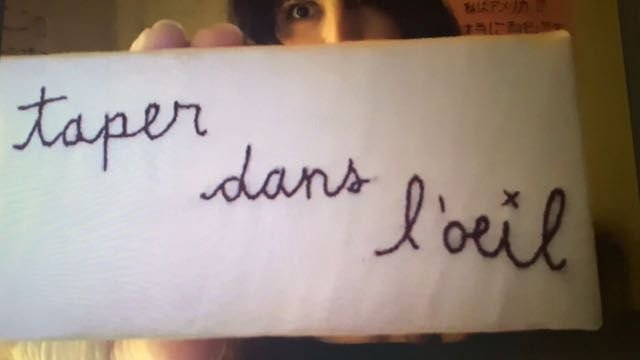Feminist Art Now: On The Work of Alisha Trimble
& Our Collaboration On The Making of The Art Video The Masque of the Red Death.
The work on the wall behind me, entitled Devour/Goya, is by Carolee Schneemann. The NY Times critic Holland Carter, in his 2019 obituary for Schneemann, who died at the age of 79, wrote that she was “a feminist visionary and one of the most influential artists of the late 20th century.”
Carolee Schneemann, Devour/Goya, 2006
In the same obituary Carter recalls that in 1999 Carolee Schneemann wrote to the MacArthur Foundation: “I am not the only woman artist with a distinguished history who has no way to sustain her work, nor provide for her future. I’m enclosing a bibliography as well as an exhibition and lecture sheet to clarify this extremely paradoxical history, the punishing facts of this mythic ‘career.’ ”
My rhetorical question to Alisha Trimble is, has this changed? Is the career of a woman artist in the United States any easier today than it was when Carolee Schneemann wrote this at the end of the 20th Century?
The critic and curator Lucy Lippard once said that feminist art rejects authoritarian certainties for an art of “openness, ambiguity, reciprocity.”
Openness, ambiguity and reciprocity are qualities that aptly express the strengths of Alisha Trimble’s work and I say this from the experience of incorporating some of her work into the video we made working together remotely during the first months of confinement necessitated by Covid 19 .
We both make cuts. It is said that in early Hollywood the reason that women were frequently film editors is because to the male hierarchy the editing table resembled a sewing machine and hence the work of an editor was considered women’s work. Making cuts inspired by those made by Trimble and spending time rearranging these and layering them was how I spent most of my time working on this video.
The apparently unmade bed behind Alisha Trimble while she dances for Prince Prospero resonates with many of us right now, who were until recently stuck at home--or still are. It emphasizes the domestic sphere that feminist art has persistently reconfigured and politicized, which at this time is a gesture whose importance has become even more obviously universal. Our confinement has been spatial but has made many of us more aware of our ideological confinement--as the scaffolding of our everyday lives has broken down—and we have been confronted with the persistent violence against black lives and also the violence against women and girls that has become even more frequent during this period. As we address the need to transform society, I predict a new wave of important works by feminist artists and a broader audience for this work.
One of the things I remember about meeting Alisha was her saying she lived in Lakeville, Connecticut, so I thought perhaps I could be helpful since I had once attended a private boys’ school in this area that had subsequently gone co-ed and so I felt might be interested in a local artist and dancer who is also a teacher of dance … so far that hasn’t panned out--but I began to know her work and we hatched this plan as Covid was breaking out to collaborate over Zoom.
The Masque of The Red Death The Zine, Alisha Trimble
Trimble has created a zine version of The Masque in connection to the video that includes a coloring book section. The eroticism in one of these drawings recalls the well-known illustrations made by the Irish artist Harry Clarke for an edition of Poe’s story published in 1919, during the 1918 flu epidemic almost exactly one hundred years ago. The presumption of immunity that erroneously circulates in the prince’s party in Poe’s story could be compared easily to the Trump White House but instead of the eroticism of Poe’s story the current ruling party produces from its denial an orgy of violence aimed at black lives, at undocumented migrants and at women.
Incipient fascism is not surprisingly already evident in the reaction online to this work of video art that Trimble and I made. For example, I deleted a post by a man who connected her dancing to mental illness and whose Facebook profile shows him cradling a military rifle with a long range scope. In recent weeks I listened to the Brazilian psychoanalyst Betty Fuks give a talk on her country’s president Bolsanaro and his use of the language of the Third Reich. During her talk she made mention of the 1989 documentary film by Peter Cohen entitled « The Architecture of Doom. » The film is about the aesthetic project of the Nazis and the centrality of this aesthetic project to their proclaimed goals. And now, similarly, in our global “society of the spectacle”--to use the term of Guy Debord to describe the overwhelming presence of still and moving images everywhere around us--there is an aesthetic project that is central to the nascent fascism of politicians like Bolsanaro, Trump and Putin. The populist curators of this aesthetic project of contemporary fascism express fear and disgust—a jouissance of ignorance, denial and aggression—towards any kind of ambiguity or complexity of meaning that offends a demand for transparency and instead elicits interpretation. The terms of disparagement recall frequently the Nazi exhibitions of modernist art that they labeled “degenerate,” comparing it to manifestations of mental illness.
One senses Trimble’s work is deeply personal and somatic, given the place of dance, fashion design and even in its foregrounding of the materiality of the signifier--as, for example, in her embroidered works-- but it is not hyper-personalized or reduced to the first person pronoun but instead lends itself to collective thinking. I hope our video stands as a testament to this dimension of her work.



